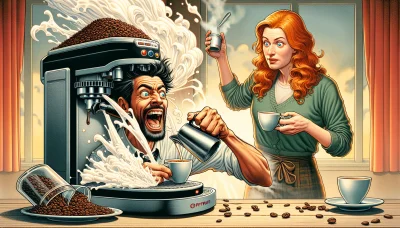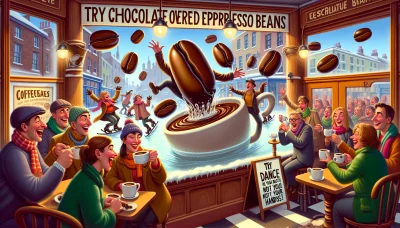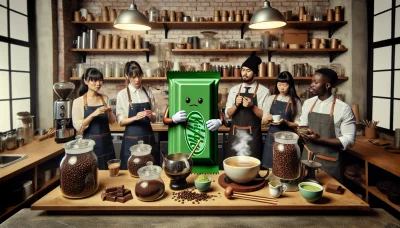Cortado vs latte Quiz
Test Your Knowledge
Question of
Cortado vs Latte: Understanding the Difference
For coffee enthusiasts, diving into the world of espresso-based drinks reveals a spectrum of flavors, textures, and experiences. Among these, the cortado and latte stand out as popular choices, each offering a unique take on the blend of espresso and milk. Understanding the difference between these two beverages is crucial for those looking to refine their coffee palate and make informed choices at their favorite cafes. This comparison aims to shed light on the key characteristics that set the cortado and latte apart, from their origins to the ratios of espresso to milk, helping coffee lovers appreciate the nuances of their favorite drinks.
What is a Cortado?
A cortado is a coffee drink that originated in Spain, offering a perfect balance between espresso and steamed milk. The word "cortado" means "cut" in Spanish, which refers to the espresso being "cut" by a small amount of warm milk to reduce its acidity. The characteristics of a cortado include a smooth texture and a strong coffee flavor, complemented by the sweetness of the milk. Unlike larger milk-based coffee drinks, a cortado is typically served in a small glass and is known for its equal parts of espresso and milk, making the ratio 1:1. This specific ratio helps in maintaining the strong coffee flavor while allowing the milk to soften the espresso's bitterness without overpowering it. To make a cortado, one starts with a shot of espresso and then adds an equal amount of steamed milk. The result is a harmonious blend that coffee enthusiasts around the world enjoy for its balance and simplicity.
What is a Latte?
A latte is a popular coffee drink that originated in Italy, known for its smooth, creamy texture and rich flavor. It is traditionally made with a shot of espresso and steamed milk, with a light layer of foamed milk on top. The term "latte" actually comes from the Italian "caffè latte," which means "milk coffee." This beverage is characterized by its high milk content compared to other coffee drinks, which gives it a milder coffee flavor. The typical ratio used in its preparation is one-third espresso to two-thirds steamed milk, with a small amount of milk foam on top. Preparing a latte requires a fine balance to achieve the perfect harmony between the boldness of the espresso and the creaminess of the milk, making it a favorite among coffee enthusiasts around the world.
The Key Differences
- Amount of Milk: A cortado has a smaller amount of milk compared to a latte, aiming for a 1:1 ratio of espresso to milk, whereas a latte has a much larger milk to espresso ratio.
- Presence of Foam: Lattes have a significant amount of foam on top, whereas cortados have very little to no foam, focusing on the smooth blend of milk and espresso.
- Serving Size: Cortados are typically served in smaller, 4-ounce glasses, emphasizing the espresso's flavor, while lattes are served in larger 8-ounce or more cups, highlighting the creaminess of the milk.
Taste and Texture Comparison
The taste and texture of a cortado and a latte significantly differ, primarily due to their distinct preparation methods and ingredient ratios. A cortado, which balances espresso with an equal amount of warm milk, offers a bold, intense coffee flavor that is slightly softened by the milk. This results in a smooth, velvety texture that allows the espresso's natural flavors to shine through. On the other hand, a latte consists of a larger proportion of steamed milk to espresso, creating a creamier, milder coffee experience. The texture of a latte is much lighter and frothier, with the milk's sweetness and creaminess playing a more dominant role in its flavor profile. Consequently, while a cortado presents a more direct and robust coffee taste, a latte offers a gentler, more diluted coffee flavor with a focus on the creamy texture of the milk.
Choosing Between Cortado and Latte
Deciding whether to indulge in a cortado or a latte can depend on several factors, including personal preference, the time of day, and what you're eating alongside your coffee. If you prefer a stronger coffee flavor with less milk, a cortado might be your go-to choice. It offers a balanced ratio of espresso to milk, allowing the coffee's boldness to shine through. On the other hand, a latte provides a creamier, more milk-forward experience, perfect for those who enjoy a smoother, gentler coffee taste.
Considering the time of day can also influence your decision. A cortado, with its equal parts espresso and steamed milk, might be the perfect mid-morning pick-me-up, offering a balanced energy boost without overwhelming your palate or your stomach. A latte, meanwhile, could be ideal for a leisurely afternoon break, its milkiness making it a soothing, comforting choice.
What you're eating can also play a role in your decision. A cortado, with its stronger coffee presence, pairs wonderfully with sweeter pastries or breakfast items, as it can cut through the sweetness and cleanse the palate. A latte, with its creaminess and larger volume, can be a meal in itself or complement a wider range of foods, from a morning bagel to a slice of cake in the afternoon.
Conclusion: Which is Right for You?
In summary, the debate between different types of coffee comes down to personal taste preferences, the desired caffeine level, and the moment's mood. While some may prefer the bold, rich flavors of a dark roast, others might lean towards the lighter, more acidic notes of a light roast. Similarly, the choice between a latte and an espresso can vary depending on whether you're in the mood for something creamy or a strong, concentrated coffee shot. We encourage you to try both types of coffee to truly understand your personal preference. Exploring the vast world of coffee can be an exciting adventure, leading you to discover your perfect cup.












